What is companion wallpaper?
Companion wallpaper is two canvases that are different in color or texture, but harmonize with each other. This finishing method has many advantages, it allows you to make the room more voluminous, hide shortcomings in area or lighting, and also gives the interior individuality.
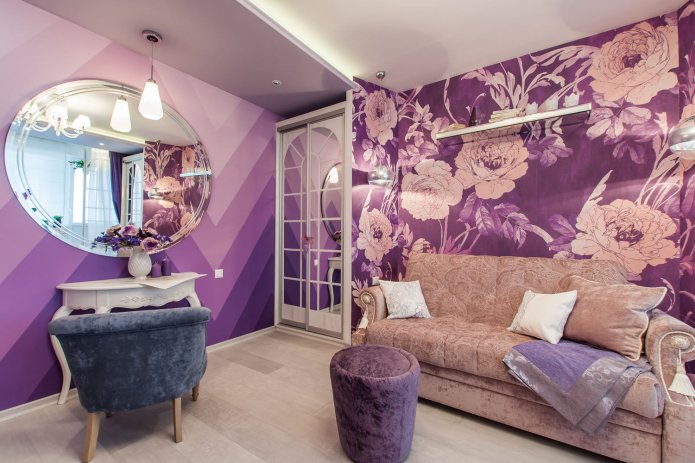

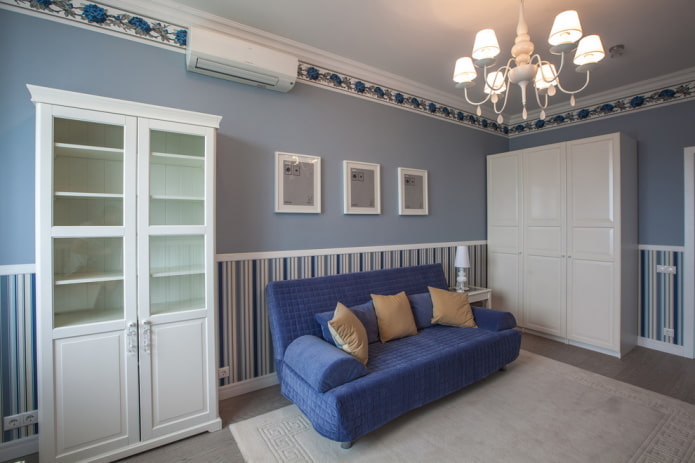

Rules for choosing companions
When choosing companion wallpaper, you should follow one rule. Two seemingly different types of wallpaper should be connected by something so that they look like a single whole in the picture of the room. This can be texture, color scheme or pattern. It is also preferable to choose companion materials of the same thickness and manufacturer; in construction stores, different variations of wallpaper combinations are often displayed on one stand, which greatly simplifies the task.
One color scheme – different patterns or textures
It is not necessary to select identical colors; different types of companion canvases can be linked by similar shades, of the same color but different tones. For example, one canvas is a solid purple color with a relief texture, another with a smooth surface and a three-dimensional pattern in the form of purple flowers on a light background.
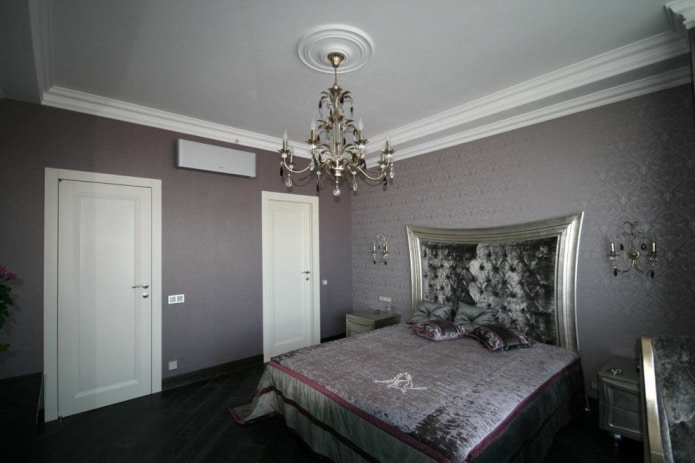
In the photo, the walls in the bedroom are finished in one color scheme with non-woven companion wallpaper. The coverings differ in pattern and texture.
This method of combining companion wallpapers will add volume to the room and make it visually larger.
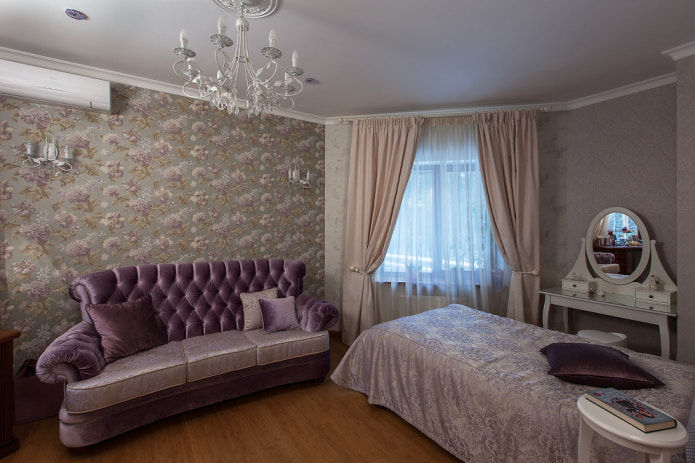
The same texture – different pattern or color
Companion wallpapers can be united by a common texture, a pronounced relief will be noticeable in any color scheme. The color selection can be contrasting, for example, black and white, or a softer combination.
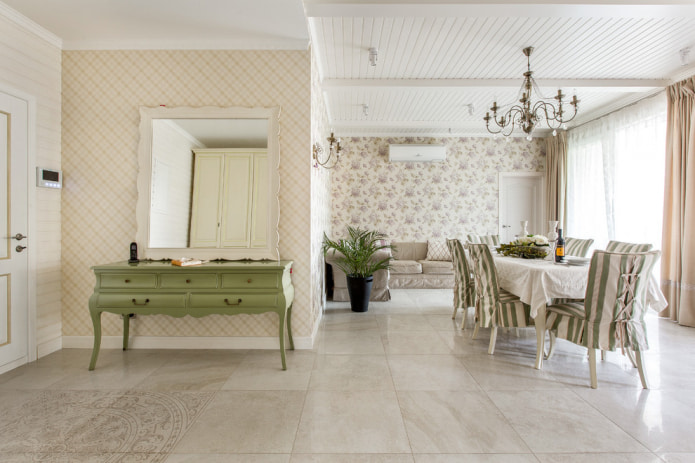
The photo shows a spacious studio apartment. Finishing with companion wallpapers with different patterns visually divides the space into zones.
The same texture of the companion wallpapers will seamlessly connect the different patterns, even on completely different images the same relief will be visible.
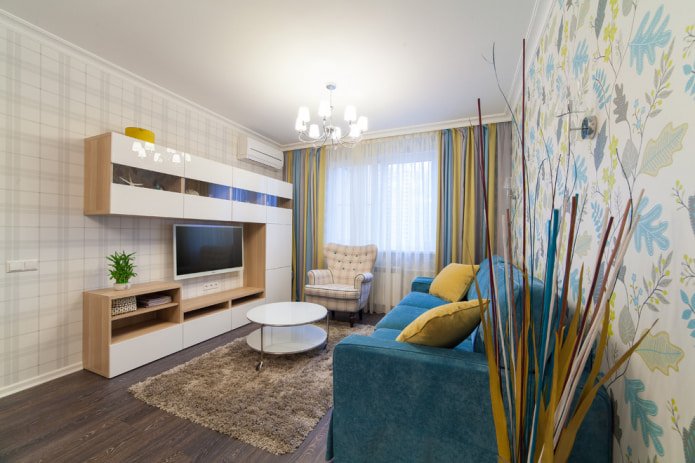
The same pattern – different texture or color
The common pattern will unite the two canvases of companion wallpapers. The image can be the same, but have different sizes, for example, on one surface there is a pattern with large monograms, on the other they are the same, but smaller.
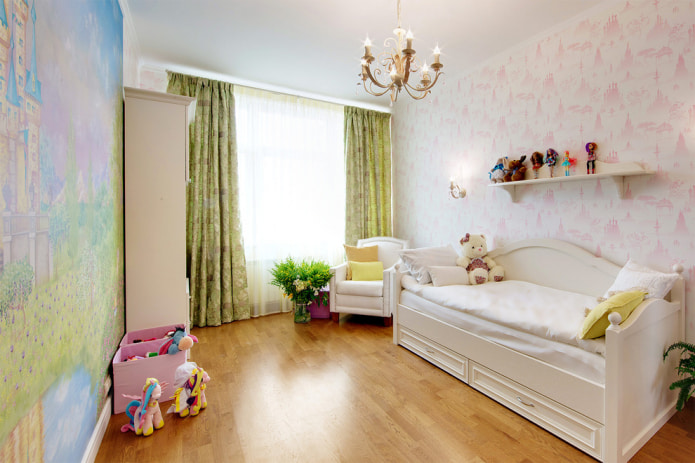
The photo shows a girl’s room. The companion wallpapers have different colors, but are united by theme. Both walls feature castles.
The same pattern can combine completely different colors and textures, companion wallpapers can be smooth and textured, contrasting and calm combinations.
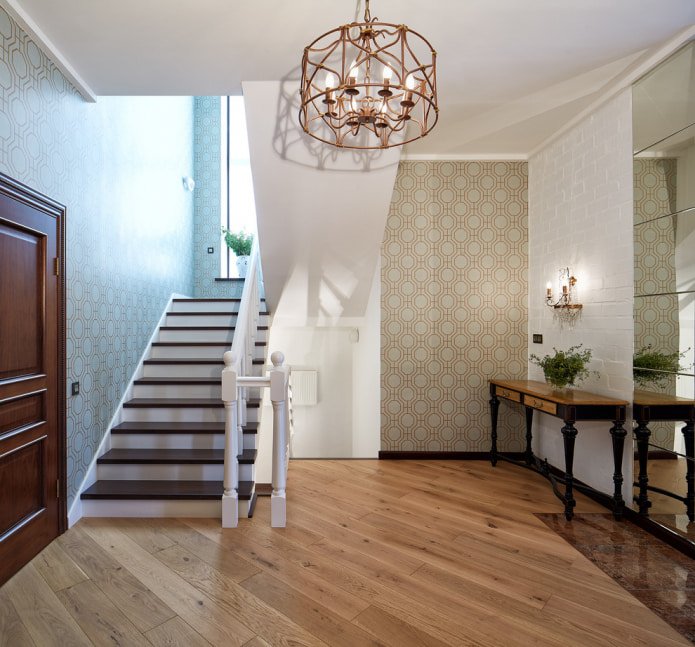
Different colors, texture and pattern
The most difficult option for decoration will be a combination of completely different types of companion wallpapers, with different textures, colors and patterns. This method of companion wallpaper should be chosen with caution, otherwise you can get a tasteless interior.
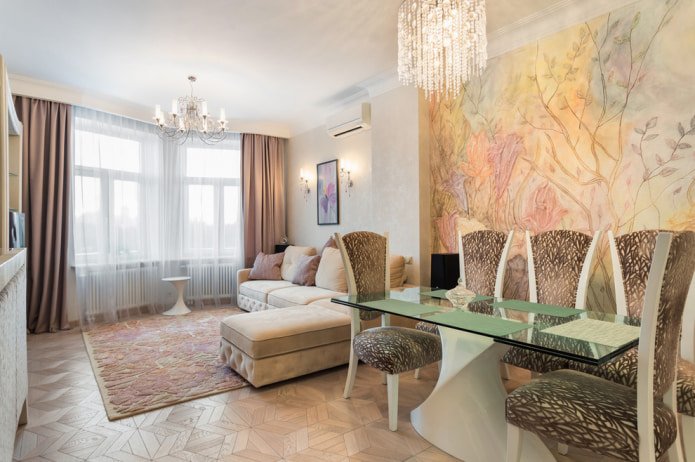
The main rule is that even completely different surfaces should be in harmony with each other. The colors can be different, but still match, for example, be pastel shades. The drawing should not be similar, but have a common theme, such as plant.
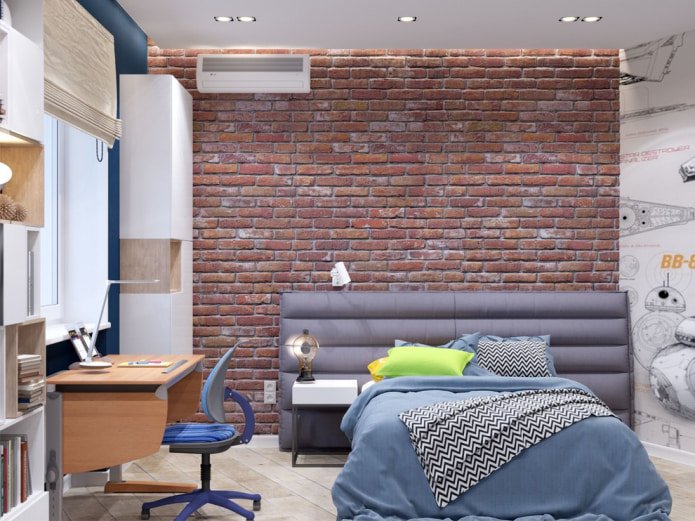
Examples of combinations in the interior of rooms
For the hall (living room)
For the living room there are more possibilities in interior design than in other rooms of the house. Unlike the bedroom or kitchen, in the living room it will be appropriate to combine companion wallpapers of bright colors and with three-dimensional patterns that can be united by a common theme.
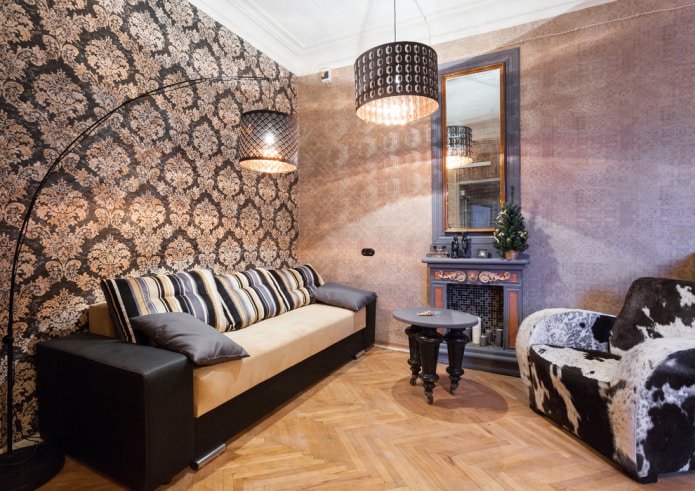
With the help of companion wallpapers you can highlight any area, for example, a relaxation area near the sofa and armchairs or a cozy place for reading. In addition, companion wallpaper will be a good interior solution for a living room combined with a kitchen, this method of decoration will help to designate zones, visually dividing them.
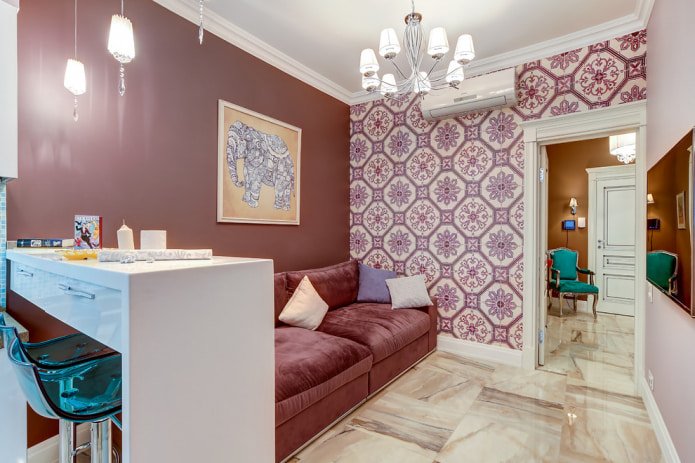
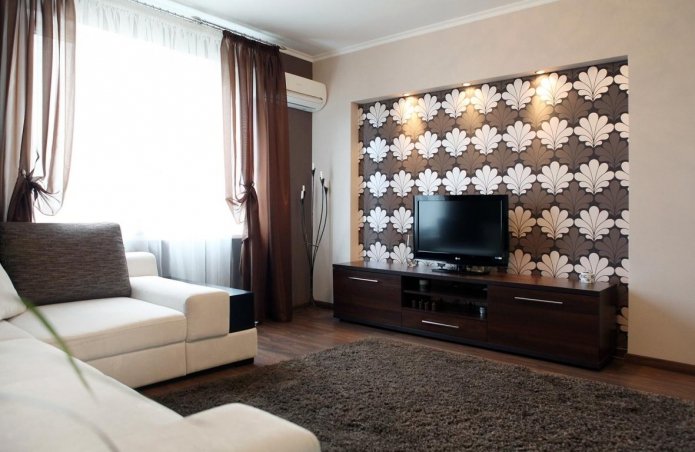
For the bedroom
Companion wallpaper is a frequent design solution for the bedroom. This method of finishing can be used to designate a sleeping or lounge area, and also to visually enlarge the space.
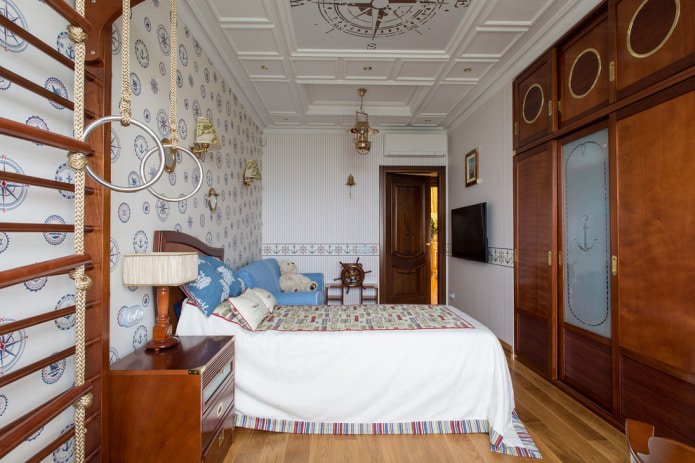
The photo shows a bedroom in a marine style. Companion wallpaper, like other items, has a pattern with a common theme.
Bright contrasting companion wallpaper can be used to decorate the wall above the headboard, thereby highlighting and decorating it.
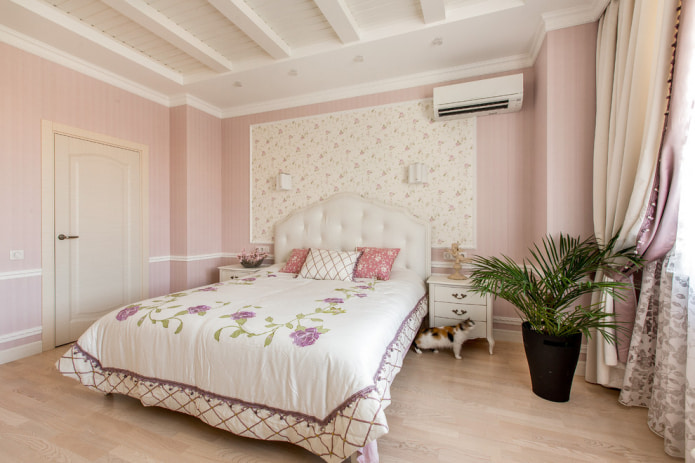
For the kitchen
Companion wallpaper will help to divide the kitchen into a work area and a dining area.
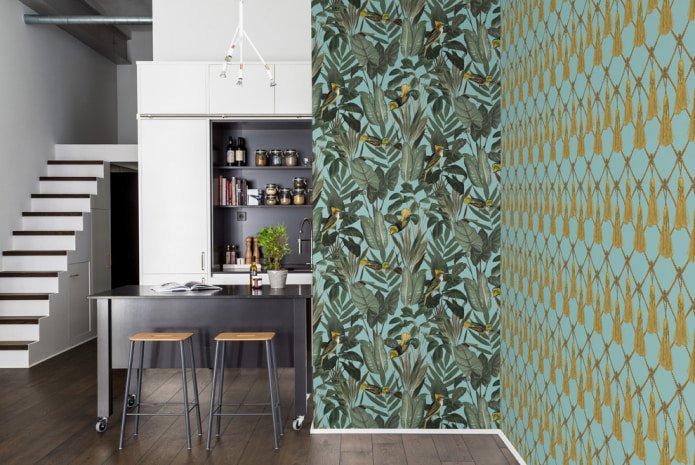
Bright wallpaper can be the entire wall of the dining area is finished or just the part directly above the dining table. The wall above the work area can also be an accent wall. Wallpaper should be protected with transparent glass above the cooking area.

For the hallway
In Khrushchev-era and standard city apartments, hallways are not very large, paired companion wallpapers will make this room more interesting and voluminous.



It will be more appropriate to use companion wallpapers of a light color palette, different patterns and textures will diversify a small space, and light colors will save space.

For a child’s room
Companion wallpaper is a great solution for a child’s room, original combinations will make the child’s room more interesting and fun. A boy’s room can be decorated in light blue tones, combined with yellow or white motifs.

Companion wallpaper in delicate colors is suitable for a girl: pink, lilac, yellow. For a child’s room, it is better to choose a calm palette, while a teenager’s room can be decorated in bolder shades.
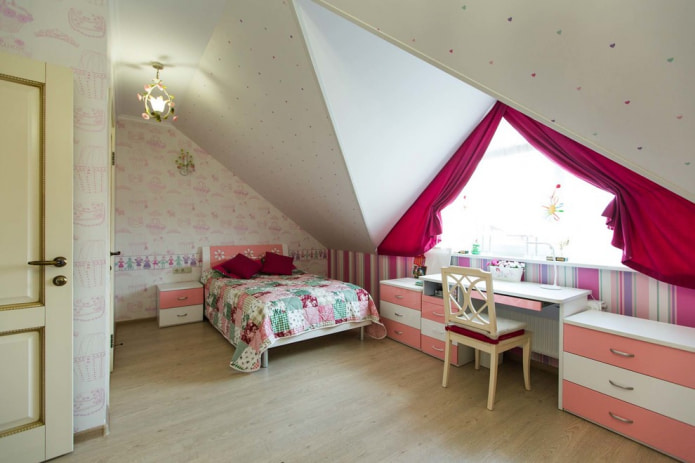
The photo shows a girl’s room in the attic. The decoration is done with companion wallpapers in a light palette with pink accents.
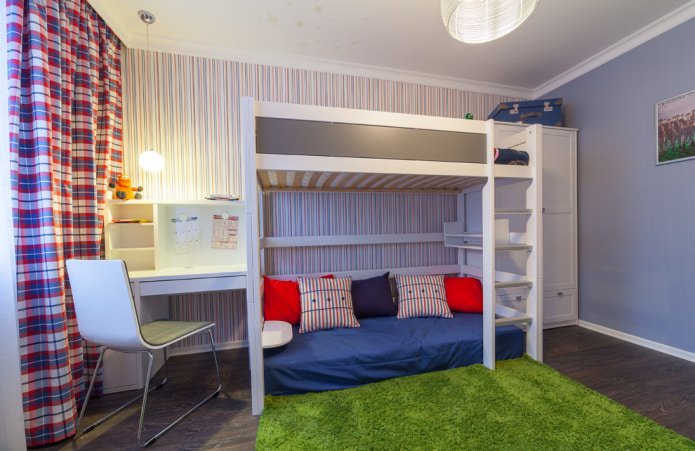
Color combination ideas
Beige
A calm universal tone combines with many colors. Beige harmonizes with bright and calm, warm and cold colors. It also successfully functions as a background. The best combinations will be with companion wallpapers in white, blue, emerald, red, brown and black. Depending on the choice of the partner color, the companion wallpaper will look good in the interior of any room.
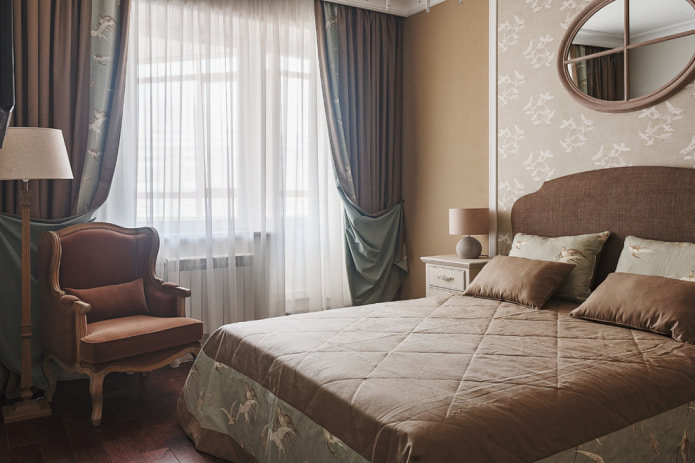
White
White tone is harmonious with any colors. The combination can be soft or contrasting, the colors rich or pastel. The combination of white and blue, red or black shades will look especially good. The texture is also clearly visible on the white background.
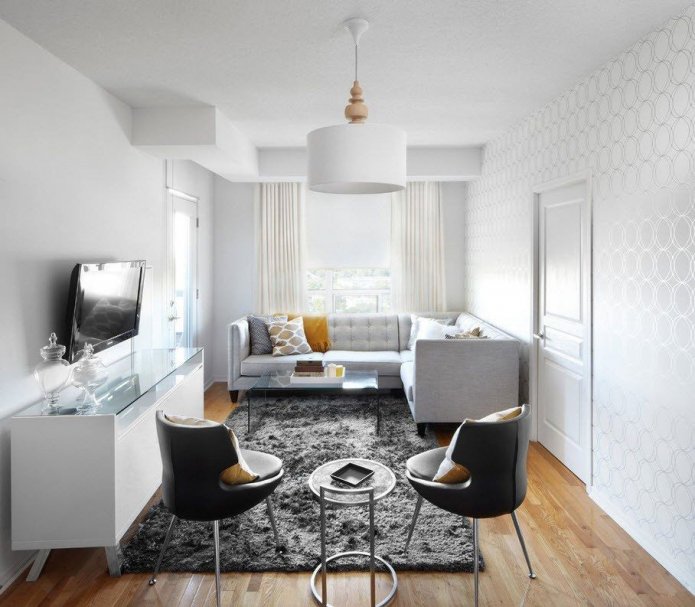
Gray
Gray wallpaper is in harmony with clean and dusty shades. Cold and warm gray tones are suitable for interior design in a modern style. The combination with pink, purple will look soft and gentle. Companion wallpapers of blue, red and fuchsia shades are a more contrasting, but no less successful combination.
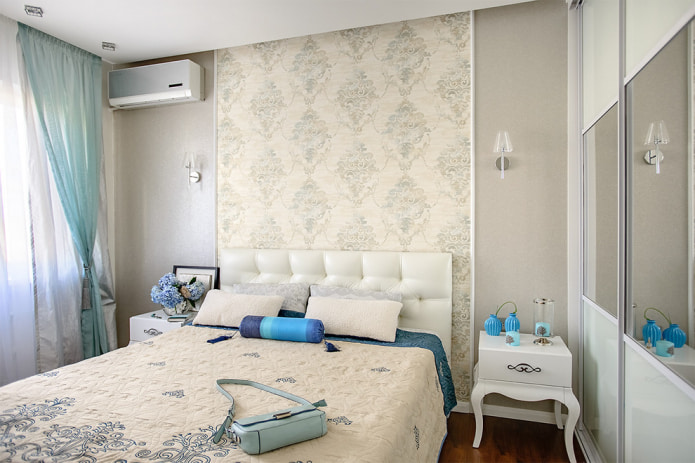
Green
The green tone of companion wallpapers will look good with warm natural shades, such as brown, gray, orange, cream, gold and black. Eco-theme will make the interior warm and the atmosphere calming.
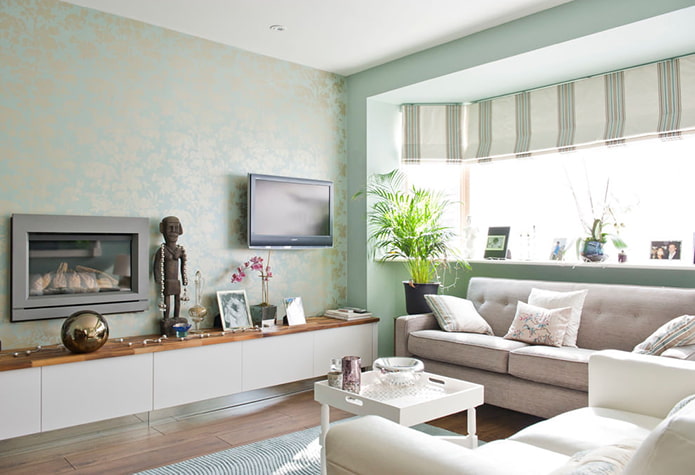
Black and white
The combination of black and white already looks complete and finished, they complement each other. However, yellow, light green, orange and purple shades can be a wonderful companion to black.
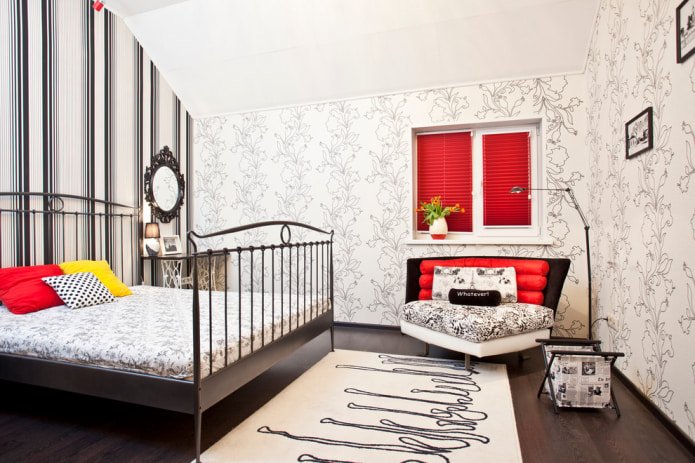
Purple
Beautiful purple color will successfully combine with gray, lilac, olive and white. Purple is suitable for interior design in a modern style. It is better to use a rich shade as a secondary one.
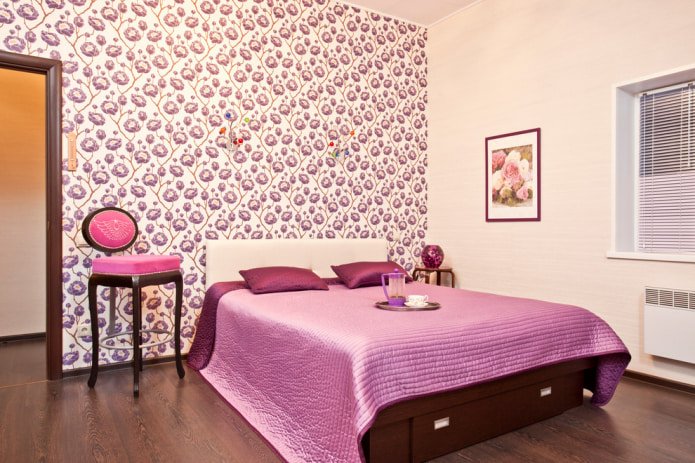
Brown
A warm chocolate shade harmonizes with blue, turquoise, green and pink. Juicy colors will stand out against a brown background. The combination with companion wallpapers of cream and beige shades is suitable for finishing the interior in a classic style.
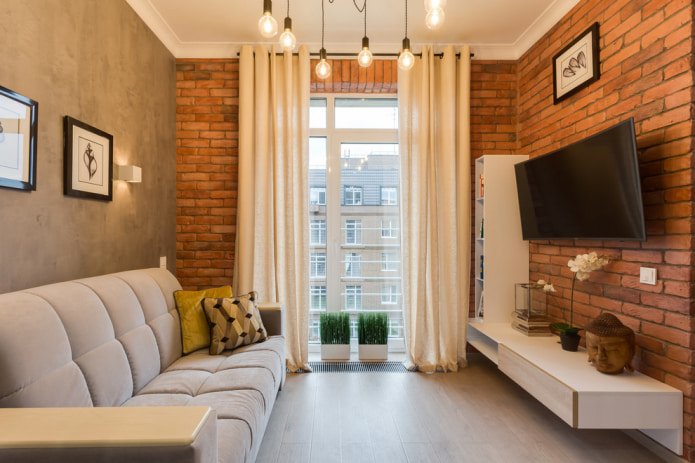
The photo shows a loft-style living room. The walls are decorated with different types of companion wallpapers, some of them imitate brickwork, others plaster.
Pink
Pink can be a delicate pastel shade or a rich fuchsia color. Light pink goes well with turquoise, light blue, mint, white, gray, olive and brown. For the fuchsia tone, companion wallpapers of mustard, gray, and salad colors will be a good companion.
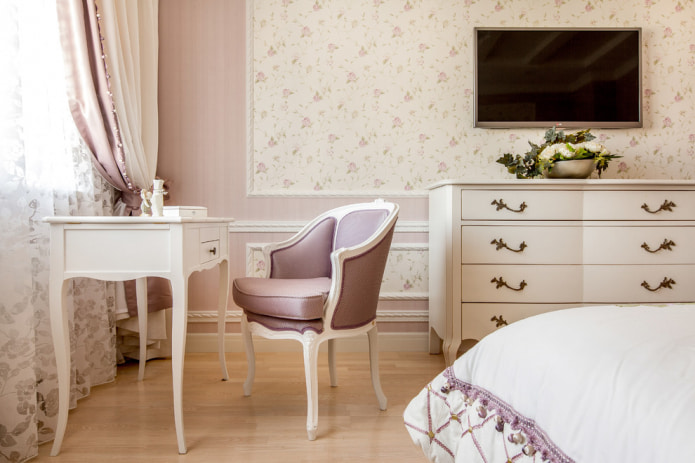
Blue
Companion wallpapers of white, gray, pink, and yellow colors go well with a delicate blue shade. Of the bright shades, red, orange, and brown are suitable for combining. Depending on the partner color, the interior will be bright and saturated or calm.
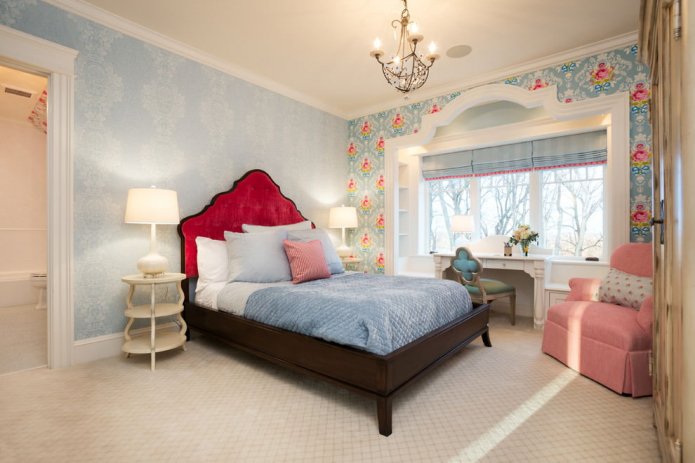
Golden
Golden accents will decorate companion wallpapers of turquoise, peach and gray colors. Gold looks impressive with companion canvases of brown, red and black tones.

Yellow
Sunny yellow combines well with companions of a cold shade: light blue, blue, gray, black and purple. Yellow will add sunshine to the room’s interior.
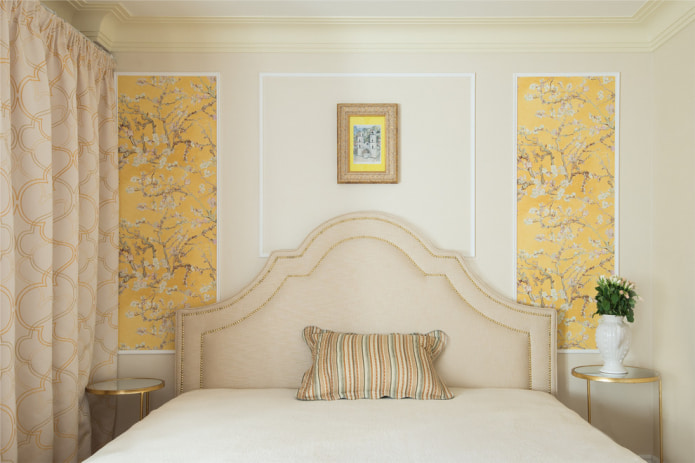
Lilac
Lilac shade can be combined with companion wallpapers of cream, light yellow, pink, light turquoise and black colors. The shade creates a delicate combination even with dark colors.
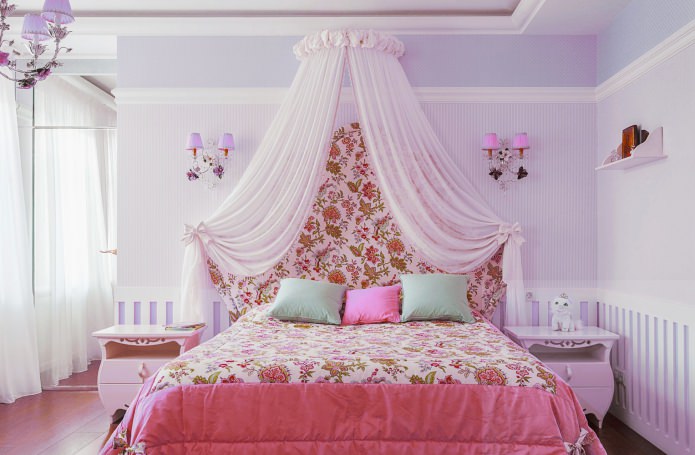
Turquoise
Refreshing turquoise will be a good companion for brown, black, dark pink, beige, white and yellow. Golden or silver elements will be a good addition.
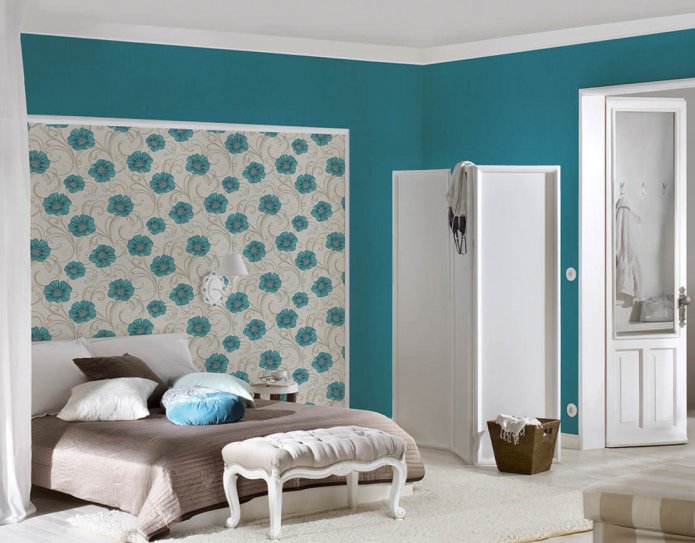
Examples of combinations by design and pattern
With flowers
The combination with a floral print is relevant for a classic, Provence or modern interior. The combination can be with plain companion wallpaper or with coverings with a different pattern. The color scheme for companion wallpapers should be chosen based on the shade of the floral pattern and its background.
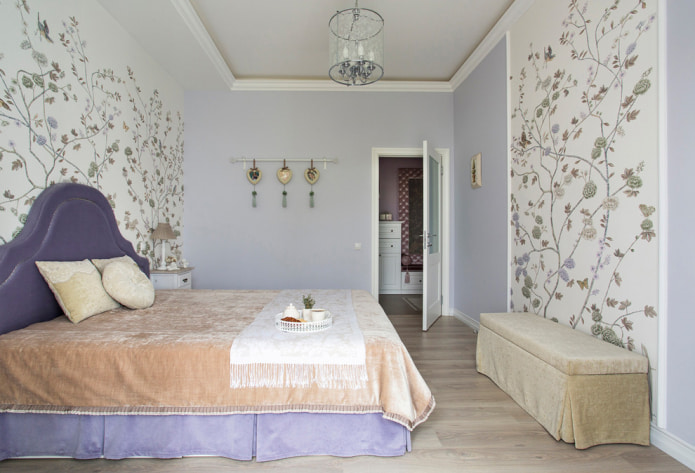
The flower pattern goes well with smooth, single-color surfaces, textured or striped wallpaper. A good finishing option would be to highlight the accent wall with companion wallpapers with flowers. For example, a three-dimensional image of roses above the headboard of the bed or sakura flowers above the sitting area in the living room.
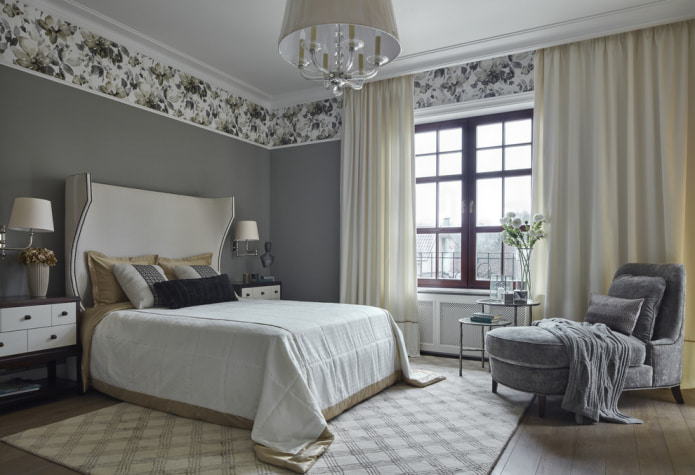
The photo shows a neoclassical bedroom. The walls are decorated with companion wallpaper in a horizontal way.
Stripe
Striped companion wallpaper can be combined with other images, patterns or textured surfaces. In addition to aesthetic pleasure, the stripe visually adjusts the space of the room; depending on its direction, the room seems wider or higher.
When combined with three-dimensional images, striped companion wallpaper should be chosen in a calm color palette that will echo the color of the pattern. In combination with textured or plain wallpaper, you can choose a bolder shade. In this case, the companion wallpaper with a striped pattern will attract the main attention.
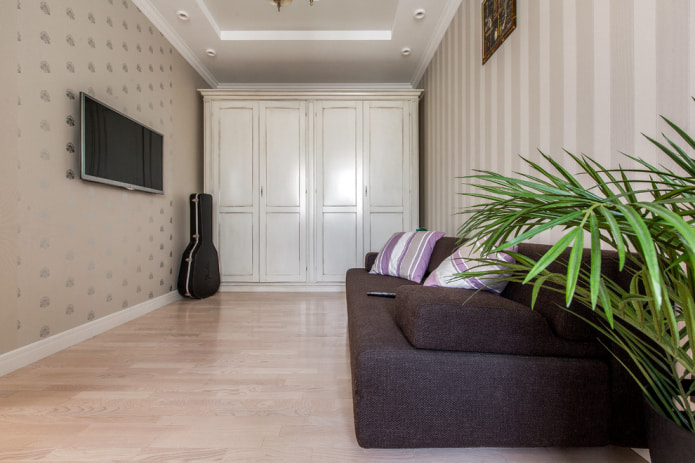
Plaster-like
Companion wallpaper with a plaster-like pattern attracts attention due to its texture. The relief surface looks harmonious with almost any type of companion wallpaper, patterns and ornaments, stripes, and 3D images will be appropriate.
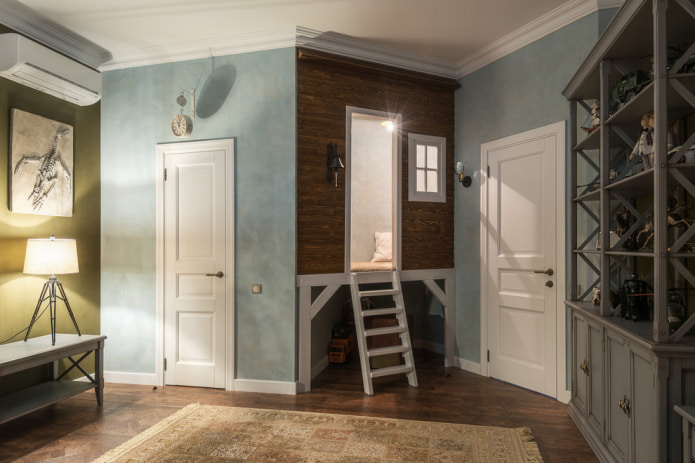
The plaster coating in the company with other companion wallpapers plays a secondary role.

Advice from a designer
There are several small tricks that will help maintain the design of the room in balance and harmony.
- To make the design with companion wallpapers look like a single picture, it is worth choosing a material of the same thickness and price segment. This will simplify the finishing work and will look neater. It is most convenient to choose companion wallpapers from the same manufacturer.
- It is necessary to consider the compatibility of colors when choosing companion wallpapers. The combination can be soft or contrasting, but the colors should match each other.
- The same applies to patterns. In the interior of one room, it is worth sticking to a single style and theme.
- When decorating the interior using the horizontal method, a larger pattern and a dark shade should be pasted at the bottom, respectively, a small pattern and a light color at the top.
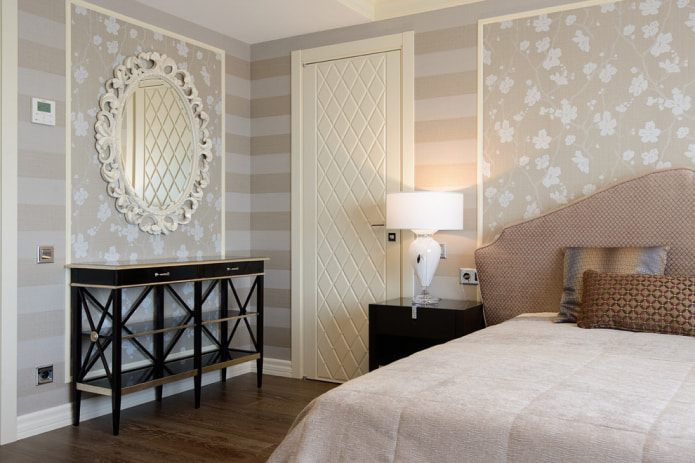
How to glue companion wallpaper?
Gluing companion wallpaper is performed according to the same principle as others, with the exception of several factors.
- Before starting work, you need to decide on the location of the canvases.
- When decorating horizontally, the companion stripes can alternate every other one, frame the wall at the edges, or have a different order. For this type of finishing, it is important that the canvases have the same thickness.
- After that, you need to prepare the surface. To do this, you need to clean the wall from the old coating, plaster it and prime it.
- To simplify the work and ensure a good result, you need to make markings on the first strip. This will prevent the wallpaper from “falling over”.
- Companion wallpaper strips are prepared. They need to be cut and laid out in the right order. The glue is applied in accordance with the requirements of the wallpaper material. The strips are glued end to end.